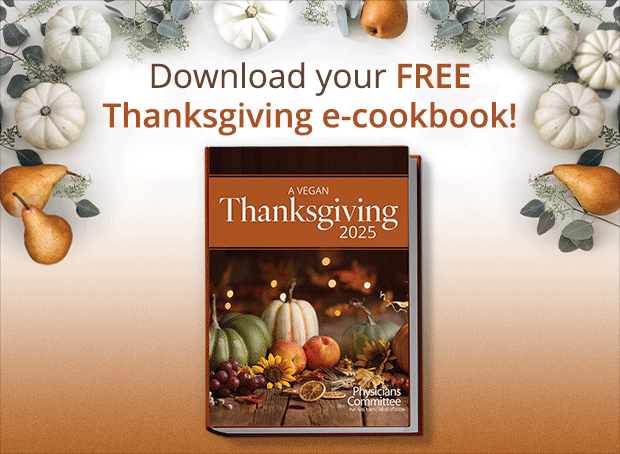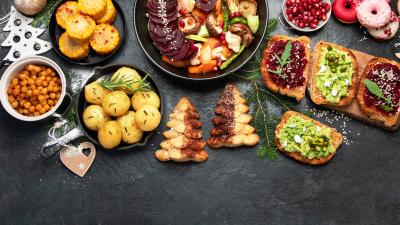A Dietitian’s Guide to a Plant-Based Thanksgiving

Thanksgiving is one of those times of year when food takes center stage. It’s familiar, a little chaotic, and built around the dishes people wait for all year. That doesn’t have to change when the menu is plant-based.
This holiday season, cost is top of mind for many. Grocery prices are higher, holiday budgets are tighter, and bird flu has negatively affected turkey prices. So if you’re looking for a way to celebrate that still feels abundant, comforting, and doable in this economy, a plant-based Thanksgiving is especially worth considering this year.
And no—this doesn’t mean reinventing the entire meal. You can keep the classics you love and the flavors you grew up with. But shifting your spread toward plants can lower your grocery bill, support your health, and still deliver a table full of dishes that feel like Thanksgiving.
In this guide, I’ll walk you through:
- Why a plant-based Thanksgiving can help you save money
- A complete under-$50 sample spread
- Ways to keep your spread familiar
- Easy store-bought shortcuts
- Menu ideas from our Thanksgiving e-cookbook
- Benefits of a plant-based spread
- A few ways to give back if you’re able
You’ll also find our free Thanksgiving e-cookbook with nearly 30 recipes available to download at the end of this post.
How Can Plants Help Save You Money
Let’s talk about the elephant (or the turkey) in the room: Groceries cost more this year.
Since January 2020, Pew Research has shown the cost of meats, poultry, fish, and eggs has risen over 36%. To make matters worse, turkey prices specifically have been hit by both inflation and bird flu disruptions, sending wholesale prices up around 40% compared with last year, according to the American Farm Bureau Federation.
Meanwhile, plant-based staples like potatoes, lentils, oats, rice, carrots, onions, cabbage, canned tomatoes, and frozen vegetables have consistently remained some of the most affordable items in the grocery store.
It’s not just anecdotal. A 2024 JAMA Network Open study found that eating a low-fat vegan diet cut grocery costs by nearly 20% compared with a typical diet. So, while affordability might not be the first thing people associate with plant-based eating, the numbers tell a very different story.
If you want more practical tips for eating plant-based on a budget beyond the holidays, I put together a full guide that walks through cost drivers, common pitfalls, and easy ways to save.
A Complete Plant-Based Thanksgiving Spread for Under $50
Here’s one example of what an affordable plant-based Thanksgiving can look like. This entire spread feeds five people comfortably.
Mains
- Sweet Potato Shepherd’s Pie
- Butternut Squash Mac and “Cheese”
Sides
- Bread Stuffing (made with vegetable broth)
- Mashed Potatoes with Mushroom Gravy
- Maple Dijon Green Beans
- Easy Maple Roasted Carrots
- Jellied Cranberry Sauce
- Wheat Rolls
Dessert
- Pumpkin Pie
Altogether, this spread comes in under $50.
Note: This estimate reflects U.S. grocery prices as of September 2025 and may vary by region or change over time.
These costs are based on the ingredients actually used—not full package prices. If you’re stocking your pantry from scratch, your total will be higher. But for most households with basic staples already on hand, this is a realistic look at what the recipes themselves cost.
Whether you’re hosting, co-hosting, or just bringing a dish, plant-based ingredients go a long way. Potatoes, beans, vegetables, and grains are inexpensive, fill out multiple dishes, and make it easier to feed a group without overspending.
If You Want Recipes, We’ve Got You Covered
If you want the recipes from the under-$50 Thanksgiving spread—or you’re looking to explore more dishes—our free Plant-Based Thanksgiving e-Cookbook includes everything you need.
Inside, you’ll find:
- Cozy starters like Creamy Mushroom Bisque
- Vibrant sides like Warm Harvest Salad with Walnut Dressing
- Hearty mains like Stuffed Honeynut Squash
- Classic desserts like Pumpkin Pie and Apple Pie Cookies
The cookbook includes all the recipes featured in the $50 spread, plus many others to mix and match depending on your preferences and budget.
We’re grateful to have contributions from recipe developers like Cathy Katin-Grazzini (Cathy’s Kitchen Prescription), Ashley Madden (The Plant-Based Cookbook), Brandi Doming (The Vegan 8), and more. Each brings their own approach to plant-based holiday cooking—familiar, comforting, and built around nourishing ingredients.
You can download the e-cookbook at the end of this post.
Keeping It Familiar (Because Thanksgiving Should Still Taste Like Thanksgiving)
Here’s something many people don’t realize until they stop to think about it: Most Thanksgiving dishes are already plant-based or very close to being so.
Stuffing? Mashed potatoes? Cranberry sauce? Roasted vegetables? Pumpkin pie?
They only need a couple small swaps:
- Vegetable broth instead of chicken broth
- Plant-based milk for mashing potatoes
- Dairy-free butter for stuffing, rolls, and pies
- Mushrooms or store-bought vegan gravy instead of meat drippings
In other words—you don’t have to throw out tradition.
And if turkey feels nonnegotiable, you still have options.
There are plenty of affordable plant-based roasts—made from lentils, seitan, or soy—that look the part, taste great, and pair well with the same sides. Some are even cheaper than buying a turkey this year. If having a “centerpiece” helps the meal feel complete, you absolutely don’t have to skip it.
If cooking everything from scratch isn’t realistic, store-bought shortcuts help keep things doable:
- Shelf-stable or refrigerated dairy-free gravy
- Canned cranberry sauce
- Whole wheat rolls
- Vegan pie crusts for quick desserts
A plant-based Thanksgiving doesn’t need to be complicated. The most important thing is that the meal still tastes like Thanksgiving—and with all of the recipes and storebought options available these days, it’s easier than ever.
The Benefits of Choosing Plant-Based
We’ve talked a lot about cost so far, but that’s not the only upside. A plant-based Thanksgiving also comes with meaningful health benefits.
Diets centered on fruits, vegetables, beans, and grains are naturally free from cholesterol, lower in saturated fat, rich in fiber, and linked with reduced risk of heart disease, type 2 diabetes, certain cancers, and other chronic conditions.
A recent Physicians Committee/Morning Consult survey found that nearly 60% of adults—and more than three-quarters of younger adults—say they’d consider a plant-based holiday meal if given a reason to try it. For many, that reason is clear: It’s affordable, sustainable, and you feel good after eating it.
If you’re interested in diving deeper into how nutrition influences health, our nutrition information pages cover core topics like protein, carbohydrates, dairy, eggs, fiber, and more.
And our health topics library breaks down how plant-based eating supports conditions like heart disease, diabetes, breast cancer, migraines, Alzheimer’s disease, and others.
Giving Back
While many of us are planning our own meals, food banks across the country are working to make sure everyone can celebrate.
If you’re able, consider donating items from our Plant-Based Food Donation List or assembling a “meal-in-a-bag” kit featuring one of our recipes, like Yes-You-Can Black Bean Chili. It’s a simple way to help someone else enjoy a healthy, hearty meal this season.
A Thanksgiving That's Kind All Around
A plant-based Thanksgiving is kind to your health, your wallet, animals, and the planet. Each dish made from whole, plant-based ingredients supports well-being, keeps grocery costs in check, spares animals from harm, and reduces the environmental strain of food production. It’s a way to celebrate abundance with intention—to honor the spirit of gratitude through choices that extend that care beyond our own tables.
Xavier Toledo, MS, RD, LDN
Xavier is a plant-based registered dietitian passionate about making nutrition education engaging and accessible. He bridges the science with practical guidance, helping people translate evidence-based recommendations into simple, actionable steps for everyday life.










